MOLE CONTROL SERVICES





HIGHLY EFFECTIVE TRAPPING
TARGETED BAITING PROGRAM
TUNNEL GASSING
Our approach to controlling a mole situation usually involves Two (2) standard measures: Trapping & Baiting. If you want to be proactive and increase the chances of the trapping being effective, you could go walk in your yard and press down on the tunnels. Therefore, when the tech arrives all tunnels that are present are active tunnels. This allows us to have laser focus and make the most out of your trapping. However, on a rare occasion we run across a situation where it warrants gassing a singular tunnel in hopes of ending the mole problem. We will then implement the Third (3rd) tool in our arsenal against Moles.
MOLE TRAPPING
The first step is setting traps in the active tunnels. These traps are designed to kill them quickly underground & humanely. There is no unsightly mess to see. We simply set the traps underground strategically and then come back to check the traps and remove any dead moles. We flag each of the trap sets above ground so you can avoid the area completely so you do not cause the traps to prematurely trip rendering them useless for trapping.
MOLE BAITING
When appropriate we can place mole bait underground to attract the moles and once they eat the bait they die. We flag where there is bait and have a method to retrieve bait before we leave if the moles have not stolen the bait and taken it back to their den. Either way, we know the bait is gone and the problem will soon be resolved.
We charge a flat-rate fee for our mole control services and we have found this to be the most we can do as humans to have the upper hand in controlling the mole population in our yard.
MOLE GASSING
This is either booked as a one-time treatment or a series of 4 visits: (Typically Initial Visit, Day 1, Day 3 and Day 7) sometimes included with the combination if left to the discretion of Wildlife Technician.
MOLE GASSING: When the situation is appropriate, we can utilize equipment designed to kill moles in their tunnels using a carbon monoxide gas.

We use a Carbon Monoxide Device that utilizes a smoke oil tracer to show you where most of the Carbon Monoxide is going. Carbon Monoxide can be used as an effective approach to control of burrowing rodents. As the Carbon Monoxide enters the burrow system, the rodent breathes it in. The Carbon Monoxide then replaces the oxygen in their blood. And without oxygen, cells in the body die and organs stop working.
Benefits of treating with Carbon Monoxide can include:
• Direct targeting of rodents within the burrow system.
• No reliance on bait acceptance that sometimes hinders rodenticide and trapping efforts.
• No secondary toxicity concerns for scavengers and predators.
• It seldom requires handling of animals after treatment, which reduces the risk of disease and parasite transmittance to humans.
• It can be highly efficacious.
• Designated as a pest control device by the EPA.
Some of the common cities that we have provided mole trapping services to are: Alpharetta, Cumming, Johns Creek, Dawsonville, Duluth, Milton, Gainesville, Dawsonville, Ellijay, Roswell, Suwanee, Big Canoe
Call us we can help!
(678)935-5900
It is amazing what damage a mole can do to a beautiful lawn. How quickly they can destroy a yard is surprising. Our mole control services can bring you quick relief. This is one of the few services that can cross-over between wildlife control & pest control. There is an easy way to explain this…
The mole lives in the seclusion of underground burrows, rarely coming to the surface. Although most people believe their yard is overrun with moles, moles are considered to be a loner. On several occasions, two or even three moles have been trapped at the same spot, but that does not necessarily mean they had been living together in a particular burrow. Networks of runways made independently occasionally join otherwise separate burrows. Because of their food requirements, moles must cover a larger amount of area than do most animals that live underground. In wet weather, runways are very shallow; during a dry period, they range somewhat deeper, following the course of earthworms.
Mole Habits
Did you know moles spend most of their lives alone and underground in their tunnels? Moles are such loners, in fact, that three to five moles per acre is considered a lot. Moles spend their time digging tunnels and hunting for food. A permanent tunnel is usually about 2 inches in diameter and 8 to 12 inches below the surface, while temporary tunnels are usually right under the surface of the ground.
Mole Diet
It is a misconception that moles eat the roots of plants. They are actually after the earthworms that are found in garden soil. Moles love earthworms so much that they eat nearly their body weight worth of earthworms per day. Moles also consume insect larvae (grubs).
Call us (678)935-5900
Frequently Asked MOLE TRAPPING & MOLE CONTROL Questions
((These are both frequently asked questions and common search engine queries))Q: What do Eastern moles eat?
A: Eastern moles primarily eat earthworms, but they may also consume other soil-dwelling invertebrates such as insects, larvae, and grubs.
Q: Are Eastern moles dangerous?
A: Eastern moles are not dangerous to humans. They are shy and elusive creatures that spend most of their time underground.
Q: How do I know if I have Eastern moles in my yard?
A: Signs of Eastern mole activity include raised ridges or tunnels in the soil, pushed up dirt piles, and small holes in the ground. You may also see a decrease in the number of earthworms in your lawn.
Q: Do Eastern moles hibernate?
A: Eastern moles do not hibernate. They are active year-round, although they may tunnel deeper into the soil during colder weather.
Q: Can Eastern moles damage my lawn or garden?
A: Eastern moles can damage lawns and gardens by creating raised ridges and tunnels in the soil. However, they can also be beneficial by aerating the soil and consuming harmful insects.
Q: How can I get rid of Eastern moles in my yard?
A: Trapping is the most effective way to remove Eastern moles from your yard. We offer a combination of mole trapping & baiting programs that have proven over the past 14 years to be highly effective when done right.
Q: How can I prevent Eastern moles from entering my yard?
A: To prevent Eastern moles from entering your yard, make sure to keep your lawn well-watered and aerated, as this will encourage earthworms to stay deeper in the soil. Also, avoid over-fertilizing your lawn, as this can attract harmful insects that moles may feed on.
Q: When is the best time of year to bait for eastern moles?
A: The best time to bait for eastern moles is during the spring and fall. These are the times of year when moles are most active and feeding heavily.
Q: How long does it take to see results from a mole baiting program?
A: It can take anywhere from a few days to a few weeks to see results from a mole baiting program. It depends on the size of the infestation and the effectiveness of the baiting program.
Q: How can I tell if I have an eastern mole problem?
A: Signs of an eastern mole problem include raised ridges or mounds in your lawn, as well as visible tunnels or holes in the soil. You may also see areas where the soil has been pushed up or disturbed.
Q: Do eastern moles carry diseases?
A: Eastern moles do not typically carry diseases that can be transmitted to humans or pets. However, their burrowing can damage lawns and gardens, making them a nuisance pest.
Q: Can I relocate eastern moles to another area?
A: First of all, how would you capture them alive? Secondly, relocating eastern moles is not recommended, as they are highly territorial and may not survive in a new location. Additionally, it may be illegal to trap and relocate wildlife in some areas.
Q: How deep do eastern mole tunnels go?
A: Eastern mole tunnels can go as deep as 2-3 feet below the surface of the soil. However, most tunnels are shallow and located within the top few inches of soil.
Q: Will eastern moles damage my plants or garden?
A: Eastern moles do not feed on plant roots or foliage, but their burrowing can damage the roots of plants and cause them to die. Additionally, their tunnels can create air pockets in the soil, which can dry out plants and make them more susceptible to damage from wind and drought.
